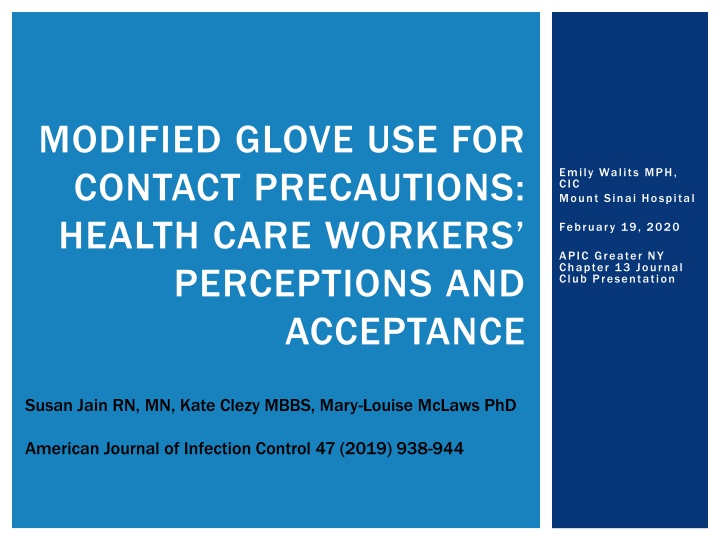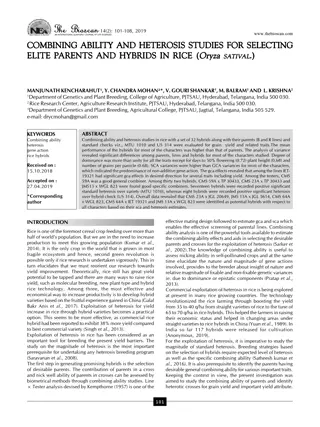
Health Care Workers' Perception on Modified Glove Use for Contact Precautions
This study explores the perceptions and acceptance of health care workers (HCWs) regarding the use of modified gloves for contact precautions. It delves into the impact of glove use on hand hygiene compliance, cross-contamination risks, and the effectiveness of contact precautions in protecting not just isolated patients but also other vulnerable individuals and HCWs. Findings reveal the influence of self-protection, knowledge on hand hygiene, and the role of modified contact precautions in improving critical thinking and nurse empowerment.
Download Presentation

Please find below an Image/Link to download the presentation.
The content on the website is provided AS IS for your information and personal use only. It may not be sold, licensed, or shared on other websites without obtaining consent from the author. If you encounter any issues during the download, it is possible that the publisher has removed the file from their server.
You are allowed to download the files provided on this website for personal or commercial use, subject to the condition that they are used lawfully. All files are the property of their respective owners.
The content on the website is provided AS IS for your information and personal use only. It may not be sold, licensed, or shared on other websites without obtaining consent from the author.
E N D
Presentation Transcript
MODIFIED GLOVE USE FOR CONTACT PRECAUTIONS: HEALTH CARE WORKERS PERCEPTIONS AND ACCEPTANCE Emily Walits MPH, CIC Mount Sinai Hospital February 19, 2020 APIC Greater NY Chapter 13 Journal Club Presentation Susan Jain RN, MN, Kate Clezy MBBS, Mary-Louise McLaws PhD American Journal of Infection Control 47 (2019) 938-944
CONTACT PRECAUTIONS & HAND HYGIENE Intent of gloves: to reduce HCW exposure to blood and body fluids Effects of glove use on hand hygiene Reduced hand hygiene compliance Increased environmental contamination/transmission Cross-contamination between procedures for the same patient Driven by reliance on gloves as self-protection The intended benefits of contact precautions are not for the isolated patient but for the protection of other susceptible patients, their environment outside the zone, and protection of HCWs from potential pathogenic microorganisms. Could contact precautions put isolated patients at risk due to decreased hand hygiene compliance?
METHODS Five health care facilities selected based on willingness to participate; Large (>400 beds) and medium (50-100) sized facilities; Australia 2016 2018 Five-phase study with 250 participants 1) pre-intervention focus group discussions (n=12) 2) hand microbiology (not presented in this paper) (n=40) 3) trial of modified contact precautions (n=100) 4) post-intervention focus group discussions (n=22 at one hospital) 5) rollout of intervention to additional wards (n=76) Focus group discussions lead by an independent research facilitator Results of discussions were transcribed and categorized by authors
RESULTS Pre-intervention findings Glove use is driven by self-protection Self-protection overrides HCW knowledge about hand hygiene Feeling that gloves are more protective than hand hygiene and that gloves replace hand hygiene Task oriented point of view guides glove use (gloves save time and effort, etc.) Post-intervention findings Self-protection associated with hand hygiene Hand microbiology lead to trust of hand hygiene methods Reduction in glove waste Altered contact precautions (phase 3) lead to more critical thinking and nurse empowerment HCW more likely to change gloves between tasks
DISCUSSION Increased hand hygiene compliance, especially before/after patient contact and after contact with patient environment Bloodstream infection rates remained the same pre- and post- intervention Modified contact precautions were practical, encouraged clinical judgement, and promoted hand hygiene
LIMITATIONS REALLY INTERESTING! BUT Group discussions How were the discussions implemented and structured? Staff may influence each other No description of study participants All RNs? If so, what about everyone else? How many were asked to participate in the discussions Would have liked more description of units on which interventions were implemented Hand microbiology study only done at one facility Applicable to C. diff? Lack of comparison of hand hygiene compliance before and after intervention or to other units on which there was no intervention Are BSIs a good proxy for transmission rates?






















